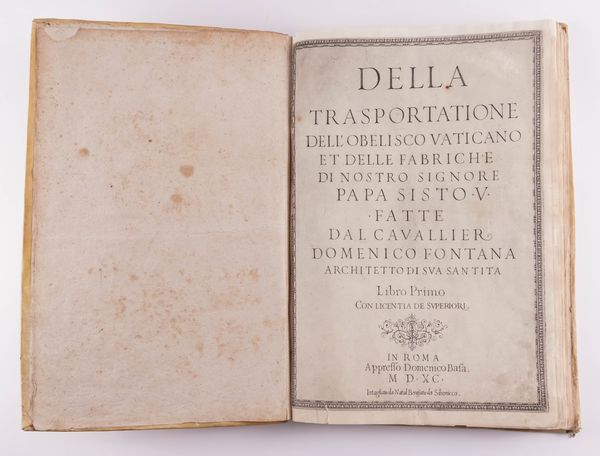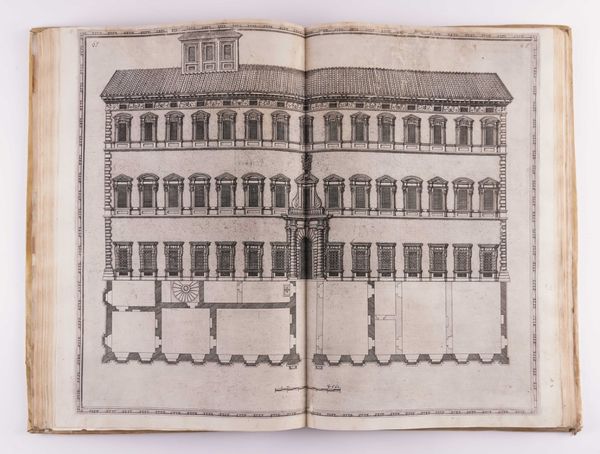FONTANA, Domenico (1543-1607). Della Transportatione dell' Obelisco Vaticano, Rome, 1590, folio, engraved title, portrait and 38 plates, contemporary vellum. FIRST EDITION.
| Estimate: | £3,000 - £5,000 |
FONTANA, Domenico (1543-1607). Della Transportatione dell' Obelisco Vaticano et delle Facriche di Nostro Signore Papa Sisto V. Fatte dal Cavallier Domenico Fontana, Architetto di sua Santita. Libro Primo Con Licentia de Superiori. Rome: "Appresso Domenico Basa ... Intagliato da Natal Bonifatio da Sibernicco," 1590 [portrait dated 1589]. Folio (406 x 265mm). Engraved title, engraved portrait of the author within an elaborate baroque architectural border surmounted by the arms of Pope Sixtus V, 38 fine etched and engraved plates by Natali Bonifazio da Sebenico, 2 of which double page, one folding, all included in the pagination, with two additional, smaller, plates on a different paper stock after Girolamo Rainaldi dated 1591 inserted at the end [as often], initials, diagrams, one-page of errata on verso of [T3], followed by "Registro" leaf with colophon (title and portrait re-margined at upper edge without loss, short tear to foot of title and portrait, a few repaired tears, mainly marginal repairs throughout, but with occasional loss to text or illustration, the loss more severe at the upper edges towards the end [see illustrations], folding plate laid down with repairs on verso, occasional light spotting, staining and browning). Contemporary full vellum, spine lettered in gilt. Provenance: From the Collection of Peter and Margarethe Braune; old signatures or labels effaced from front pastedown; later pencil code numbers to front free endpaper; the first of the two additional plates by Rainaldi inscribed in a contemporary hand, "Fatto in Santa Maria Maggiore, quando si fece la transportatione del Corpo della felice memoria a di P.P. Sisto V. la pianta et l' elevato" [the same "additional" plate in the copy in the Folger Library contains an almost identical contemporary inscription]. FIRST EDITION. "The obelisk that now stands before St. Peter's was brought from Egypt by Caligula, an amazing achievement of which interesting accounts have been left by Pliny and Suetonius ... [I]t [originally] stood to the left of old St. Peter's, and in the Middle Ages was believed to contain the ashes of Julius Caesar ... Around 1500, when Bramante was designing the new St. Peter's, he happened to read, in the Hypnerotomachia, that an obelisk placed before a temple would act as a reminder of the mortality of man ... Eighty years later Sixtus V embarked on the most sweeping and effective programme of town-planning ever undertaken, changing a pagan into a Christian city and causing us even, even today, to speak of 'Sistine Rome'. As obelisks formed the pivots of his most important vistas it was intolerable to Sixtus that the greatest piazza of all should be without this feature - so he decided to move the obelisk that stood to the side of St. Peter's. A multitude of plans (some say five hundred) were examined before the task was allotted to Domenico Fontana. He employed 900 men and 140 horses and designed the construction of elaborate machinery including 46 windlasses. The obelisk was moved round to the Piazza on 30 April 1586 ... Fontana was rewarded and ennobled ... Elated with pride, he sought to ensure lasting glory for his achievement with a book, illustrated with fine engravings, Della Transportatione dell' Obelisco Vaticano ... The illustrations in this book of lift and pulley constructions had a lasting influence upon the techniques of theatrical scenery. It is interesting to note that Matthew Goodericke, who worked on the scenery for masques designed by Inigo Jones, owned a copy that has survived" (Alan G. Thomas Great Books and Book Collectors (1975) pp.179-180). The collation runs as follows: initial blank, engraved title [unsigned], engraved portrait [unsigned], followed by A2-[T4], with pagination, sometimes in manuscript, on rectos only, including the plates. Although the book is described on the title page as 'Libro Primo', no second volume was printed until the first was republished [i.e. in a second edition] in 1604, hence this volume, we believe, can be considered complete in its present form. Berlin Kat. 2652; Brunet II, 306: "Ouvrage curieux ..."; Cicognara 3736: "Opera pregevole ..."; Dibner Heralds of Science 174; Fowler 124: "[the plates] are important examples in the development of architectural drawing"; Mortimer Italian 193; Norman 812; Olschki 16955: "Ce beau volume ... [the plates are] remarquables au point de vue artistique autant que technique"; Riccardi I, 466.

















